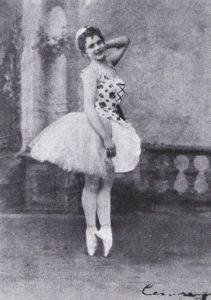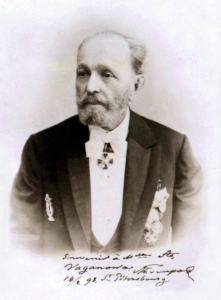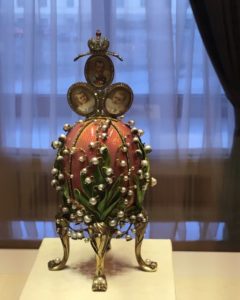by Tasha Alexander
While the principal characters in Death in St. Petersburg are fictional, there are a handful in supporting roles (beyond Nicholas II and his wife, Alexandra) who were real.
Marius Petipa, the renowned choreographer, made Russian ballet the greatest in the world. He hugely admired Pierina Legnani, who pioneered the now-famous thirty-two fouettées still performed by ballerinas in Swan Lake (she did, in fact, first perform the feat in Cinderella). Mathilde Kschessinska, another prima ballerina assoluta, was Nicholas II’s mistress before he married his wife. In her memoirs, she records him as hesitant to consummate their relationship because of her inexperience. He did not want her to regret her actions. Somehow, she must have overcome his concerns. I based many of my dancers’ experiences on incidents from her life. Olga Preobrajenska danced with the Imperial Ballet and later became a teacher, eventually settling in Paris after the Russian Revolution. Not so well known among her many famous pupils (including Margot Fonteyn and Tamara Toumanova) was Marie Buczkowski, who eventually moved to South Bend, Indiana, where she opened a ballet studio. I was fortunate enough to be one of her students.
Excerpt from Death in St. Petersburg
January 1900

After the curtain fell on the final scene, the crowd exited the Mariinsky Theatre bursting with energy and brimming with emotion, profoundly affected by the story of Prince Siegfried and the cursed Odette, who could be united only in death. Never before had I seen dancing like that, and from the animated chattering around me, I knew the rest of the audience had been as delighted as I.
We had all expected an exceptional performance. Irina Semenova Nemetseva, the young dancer only a few years out of school, whose meteoric rise through the ranks of the Imperial Theatre was already the stuff of legends, would make history tonight as the first person other than Pierina Legnani to dance the dual roles of Odette and Odile in Tchaikovsky’s Swan Lake. Marius Petipa, the great choreographer and ballet master of the Mariinsky, had named Legnani the first prima ballerina assoluta, the highest rank a dancer could achieve. He adored her and all but gave the ballet to her. He had developed the choreography especially for her, and she had caused a sensation by adding thirty-two fouettées, in which the dancer whipped her leg around while turning en pointe with impossible speed, to her solo in the third act, a feat she had first performed in Petipa’s Cinderella, years earlier. Now close to her fortieth birthday, and no doubt knowing retirement was not far away, Legnani had agreed to let someone else dance the role and chose Nemetseva as her successor.

The audience had not seen the girl’s fouettées.
An extra element of excitement was added to the performance when, before the third act, a man—Petipa himself, I learned from the more experienced ballet goers around me—had stepped out from behind the heavy red velvet curtain and called for silence. We all obeyed at once, as if God Himself had made the request. Then, in a loud, steady voice, he announced that the dual role of Odette/Odile would be danced for the remainder of the performance by Ekaterina Petrovna Sokolova. He gave no explanation, but irritation was evident on his face and in his tone. I wondered what had prompted the change, as did everyone around me. Chattering filled the theatre, and the conductor, when he appeared at his podium, had to turn around three times and glower before it became quiet enough for him to raise his baton and command the orchestra to play.
Whatever the cause of the last-minute substitution, Ekaterina Petrovna had risen to the occasion with aplomb. She looked the opposite of Nemetseva, her pale, golden hair a perfect contrast to her colleague’s smooth, dark locks. This made it a tad hard to believe that she could have deceived Prince Siegfried into believing she was the same girl he had fallen in love with before the interval, but from the moment she started to move, she captivated the entire theatre. By the final act, no one remembered that earlier that night someone else had danced the role.

And now, as we poured out into the frigid night, everyone bundled in furs, Theatre Square was full of smart carriages waiting to collect their fashionable owners. I almost didn’t hear the first scream, but the second was impossible to ignore. It pierced the taut air like a blade.
Nothing should have been capable of silencing the bustle in front of the Mariinsky, but by the time I heard a third scream, this one joined by a voice crying, “Nemetseva!” over and over, it was as if a sorcerer had cast a spell over the entire crowd. Everyone fell quiet and started to move almost in slow motion, following the sound of the cries. Colin, who had taken me firmly by the arm to keep us from getting separated, was the only person moving at full speed. Faster than that, in fact. He knew, as did I, that something was dreadfully wrong. We skirted the side of the building until we came to the source of the screams.
Two elderly women, their programs from the performance still clutched in their hands, were standing next to a delicate spray of crimson blood that colored the snow around the body of a ballerina. Beneath her, the oozing liquid was neither delicate nor crimson; it had pooled thick and dark. She was still dressed in a white tutu, its bodice and its full, stiff skirts decorated with feathers and glittering crystal beads. The ribbon on one of her satin slippers had come undone, but her tiara, pinned to her dark hair, remained perfectly in place.
“Stay back,” Colin said, stepping forward and raising a hand to keep the crowd, now arriving in droves, at bay. He knelt on the ground and bent over her. There was no need to check for a pulse. No one could have survived the loss of so much blood. Someone shouted for the police; someone else began to sob loudly. The ballerina was on her stomach, but her face was turned to the side, visible enough to be recognized by her fans.
“Irina Semenova!” a woman cried, and dropped to her knees, making the sign of the cross. “It is not possible!”
Colin spoke a few words of perfect Russian to the policemen who had now arrived and turned to me, a grim look on his face. “Go home with Cécile and Masha. You may as well stay with them tonight. I shall be late.”
I knew better—rather, I had learned after years of unsuccessful attempts—than to argue with Colin at the scene of a crime. He excelled in his role as agent for the Crown, but I, too, had work of my own, and had proved my mettle as an investigator time and time again. Seeing this beautiful girl drenched in her own blood, I desired nothing more than to apply myself to the task of finding her murderer, but I knew I could not insert myself into the investigation, at least not yet. Patience was a virtue I was doing my best to acquire; the results I achieved might generously be described as varied.
I watched my husband stride purposefully back to the theatre and disappear inside. Cécile appeared seemingly out of nowhere and took me by the arm.
“Come, chérie, Masha’s carriage is here. I cannot bear to look at this for a moment longer.”

I did not do as she bade but pulled away and approached to the dainty figure on the ground. The dancer’s arms were outstretched, and her legs crossed in a hauntingly graceful manner. Even in death she looked a ballerina. I caught a glimpse of something golden beneath her. A burly policeman glared at me, but I ignored him and reached for the object. Now he intervened and stopped me, handling me more roughly than I felt strictly necessary. I gave him a stiff rebuke in his native tongue. Having always had an affinity for languages, I had, over several years, made a casual study of Russian in anticipation of someday visiting St. Petersburg. My command of the language fell far short of fluency, but I was not completely hopeless. Nonetheless, he pretended not to understand when I spoke to him. I switched to French, which was spoken by everyone at the Romanov court, but not by many ordinary Russian people. It was clear his command of that language was far more lacking than my Russian. Giving up, I crouched down, close to the body, and pointed to the bit of gold. He barked something to the other police, one of whom moved it slightly, revealing what lay beneath: a small, oval object, no more than six inches long. He picked it up, pulled out a handkerchief from his coat, and wiped a spatter of blood from its surface.
It was an egg, covered in pink enamel and perfect pearl lilies of the valley, topped with a small, diamond-encrusted imperial crown. I recognized it as the work of Carl Fabergé, but before I could take a closer look, another policeman rudely moved me away. Masha, who had stayed back with Cécile, berated him in loud Russian. He did not appear affected by this in the least and shoved me in the general direction of my friends. Cécile kept me from losing my balance on the icy pavement and bundled me into the waiting carriage.
Interested in reading more from Tasha Alexander? Check out Chapter 1 on Death in St. Petersburg on CriminalElement.com!
Tasha Alexander is the author of the New York Times bestselling Lady Emily mystery series (Tears of Pearl, Dangerous to Know, and A Crimson Warning). The daughter of two philosophy professors, she studied English Literature and Medieval History at the University of Notre Dame. She and her husband, novelist Andrew Grant, live on a ranch in southeastern Wyoming.
